Steel Markets

May CPIP Data Shows Construction Spending Accelerating
Written by Peter Wright
July 9, 2018
Construction spending has accelerated for six straight months, according to Steel Market Update’s latest analysis of Commerce Department data. Growth of total construction expenditures on a rolling three-month basis year over year increased from 0.9 percent in November 2017 to 4.4 percent in May 2018.
In the DOC’s July 2 release, which included data through May of this year, the values for expenditure by sector were revised back to January 2016. The growth of total construction on a rolling 12-month basis year over year increased from 2.0 percent in January to 2.3 percent in May. On a rolling three-month year-over-year basis, the situation is much better, with growth improving every month from December through May when it reached 4.4 percent.
Construction expenditures data developed by the Department of Commerce and is referred to as construction put in place (CPIP). Since construction is extremely seasonal, the growth or contraction we report in this analysis has had seasonality removed by providing only year-over-year comparisons.
At SMU, we analyze the CPIP data to provide a clear description of activity that accounts for about 45 percent of total U.S. steel consumption. See the end of this report for more detail on how we perform this analysis and structure the data. In particular, note that we present non-seasonally adjusted numbers, and we don’t include expenditures for residential improvements. Our rationale is that construction is highly seasonal and our businesses function in a seasonal world, and home improvements don’t consume much steel. For these reasons, our results may not align with other sources.
Total Construction
Total construction expanded by 4.4 percent in three months through May and by 2.3 percent in 12 months through May, both year over year. Since the three-month growth rate is higher than the 12-month rate, we conclude that momentum is positive. May construction expenditures totaled about $94.5 billion, which breaks down to $68.4 billion of private work, $24.3 billion of state and locally funded (S&L) work, and $1.9 billion of federally funded work (Table 1). Growth trend columns in all four tables in this report show momentum.
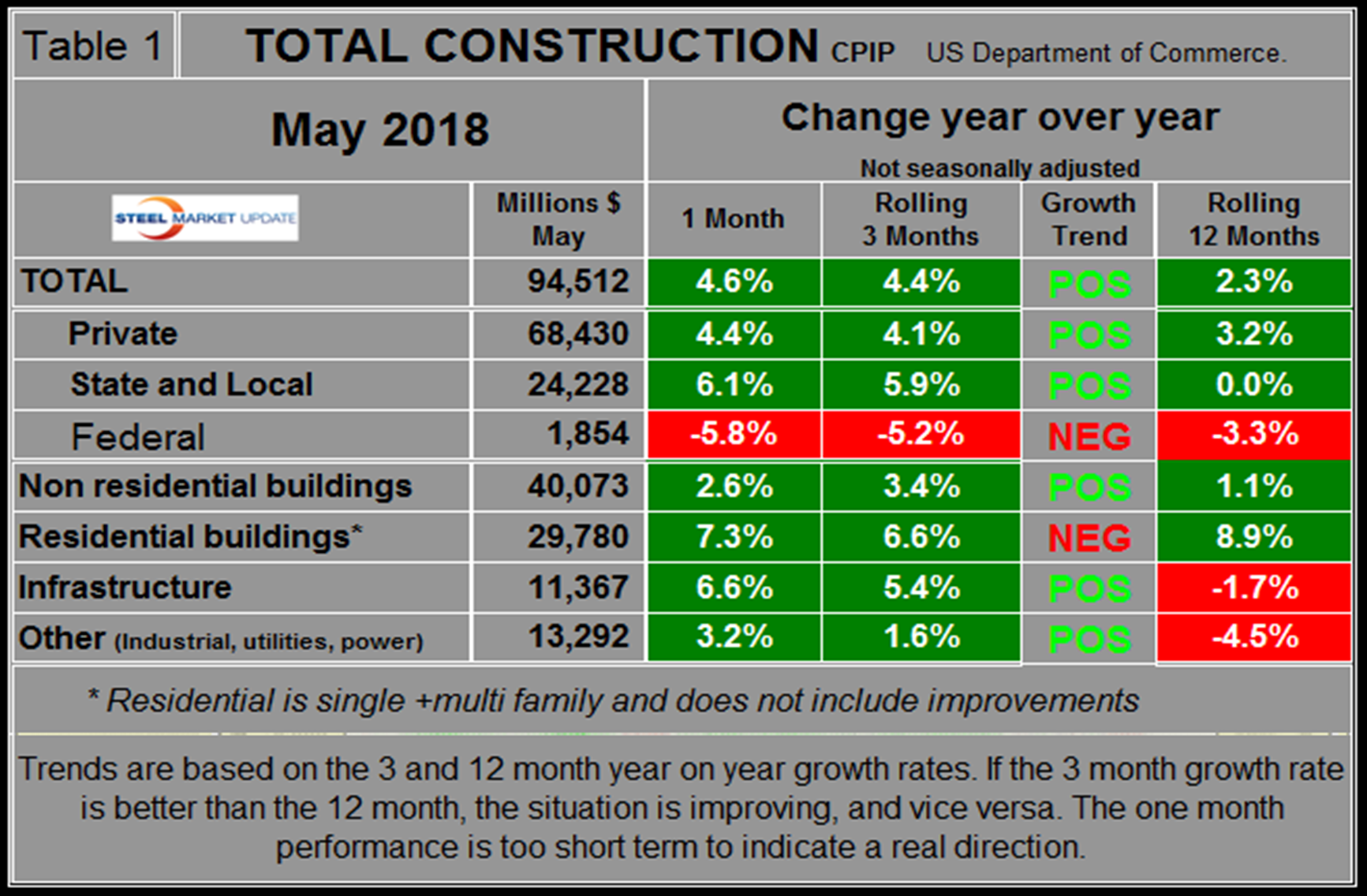
Figure 1 shows total construction expenditures on a rolling 12-month basis as the blue line and the rolling three-month year-over-year growth rate as the brown bars. Total construction is at an all-time high.
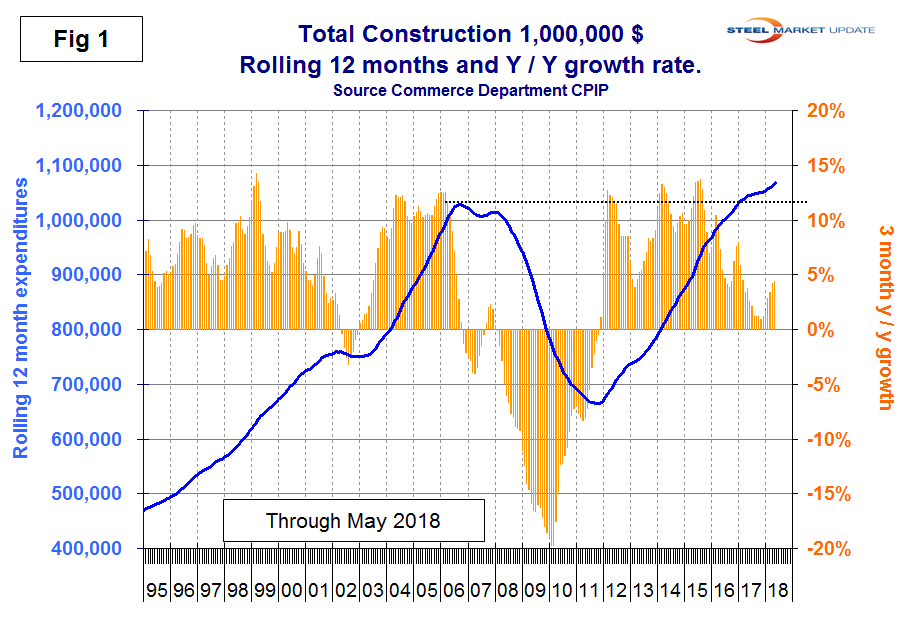
Figures 1 through 4 in this analysis have the same format, the result of which is to smooth out variation and eliminate seasonality. We consider four sectors within total construction. These are nonresidential, residential, infrastructure and other. The latter is a catchall and includes industrial, utilities and power. Of these four sectors, only residential buildings had negative momentum in the May data, which was the same as the previous four months’ results.
The pre-recession peak of total construction on a rolling 12-month basis was $1.028 trillion through November 2006. The low point was $665.1 billion in the 12 months through April 2011. In 12 months through May 2018, construction expenditures totaled $1.068 trillion. (This number excludes residential improvements; see explanation below.)
Private Construction
Table 2 shows the breakdown of private expenditures into residential and nonresidential and subsectors of both. The growth rate of private construction in three months through May 2018 was 4.1 percent, up from 1.9 percent in the three months through last November as shown by the brown bars in Figure 2. As a result of the revisions reported this month, private construction has finally reached the pre-recession rate of expenditures.
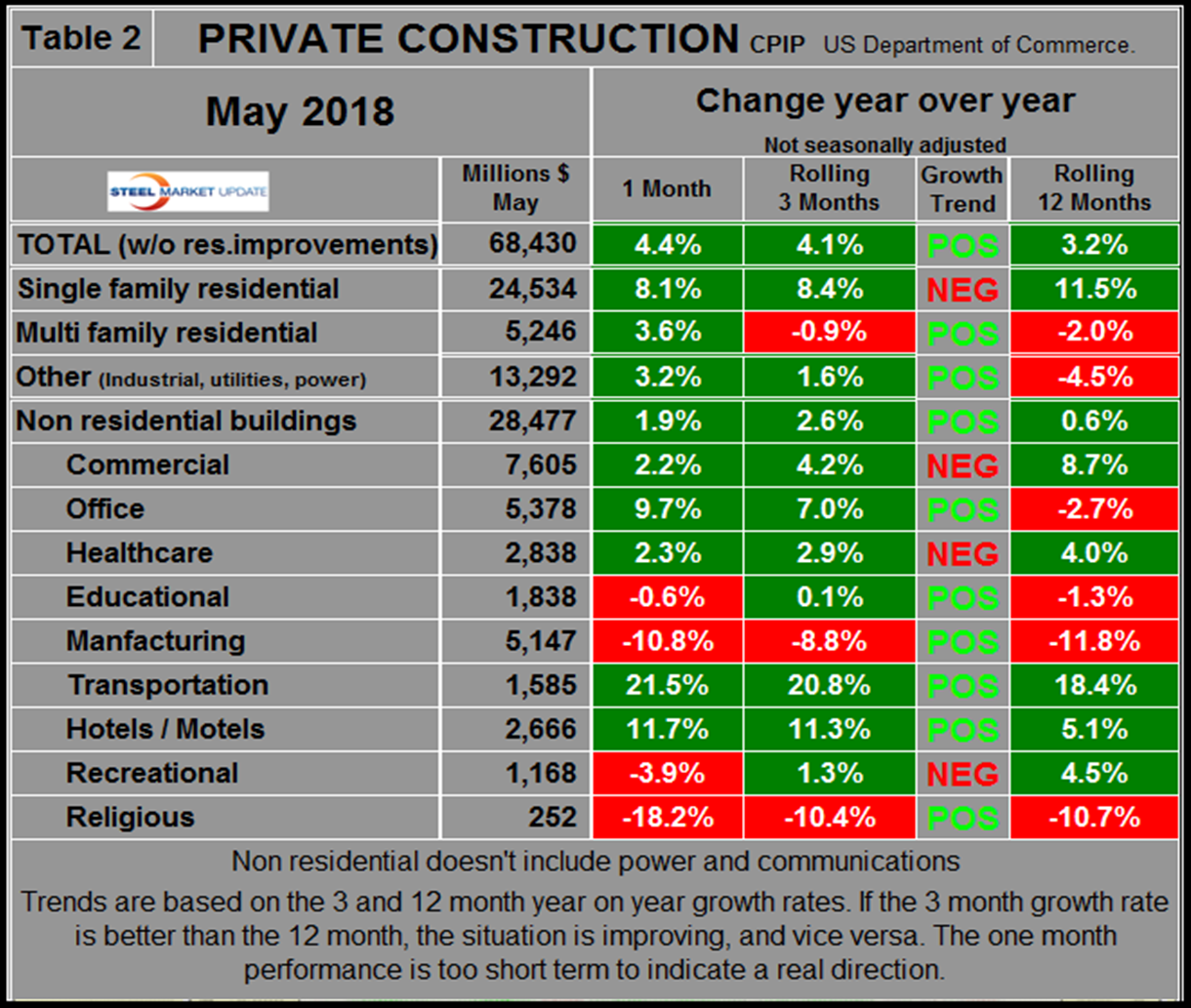
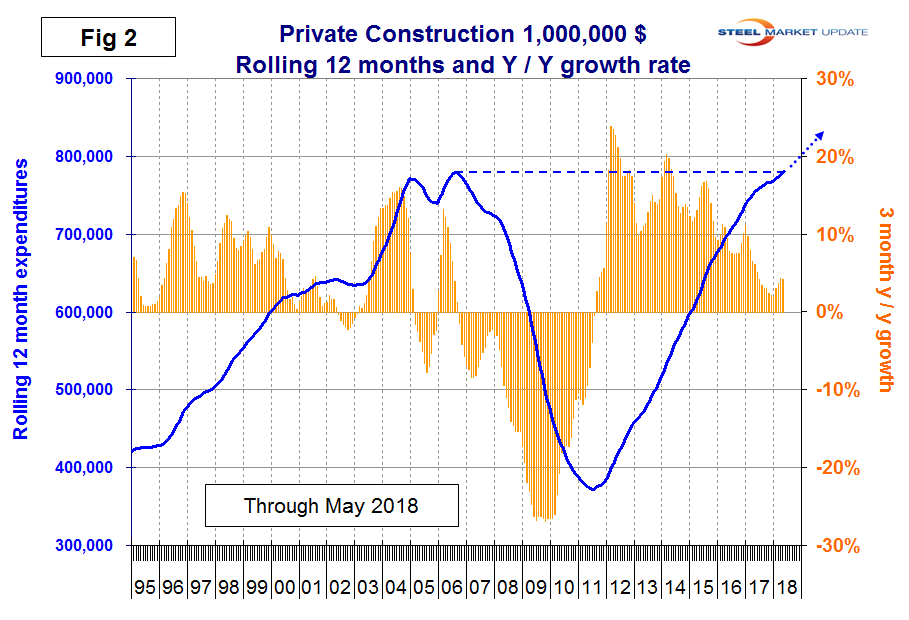
Excluding property improvements, our report shows that single-family residential grew by 8.4 percent in three months through May with negative momentum and multifamily residential contracted by 0.9 percent with positive momentum. Homebuilder sentiment is high, but has been declining since last December. In our view, the 2018 tax legislation and rising interest rates put single-family home construction in jeopardy.
Within private non-residential buildings, all sectors except commercial (mainly stores), health care and recreational had positive momentum.
State and Local Construction
S&L work expanded by 5.9 percent in the rolling three months through May year over year with positive momentum. However, January through May were the first months with positive growth since 2016 (Table 3). The improvement was driven by nonresidential buildings and infrastructure, both of which are included in the S&L data. Table 3 shows that S&L nonresidential buildings expanded by 5.4 percent in three months through May, which was the best result since March last year. Educational buildings are by far the largest subsector of S&L nonresidential at $7.074 billion in May and experienced a 1.9 percent positive growth on a rolling three months basis with positive momentum. Figure 3 shows the history of total S&L expenditures and that a full recovery to the pre-recession level of expenditures probably won’t be achieved until sometime in the next decade.
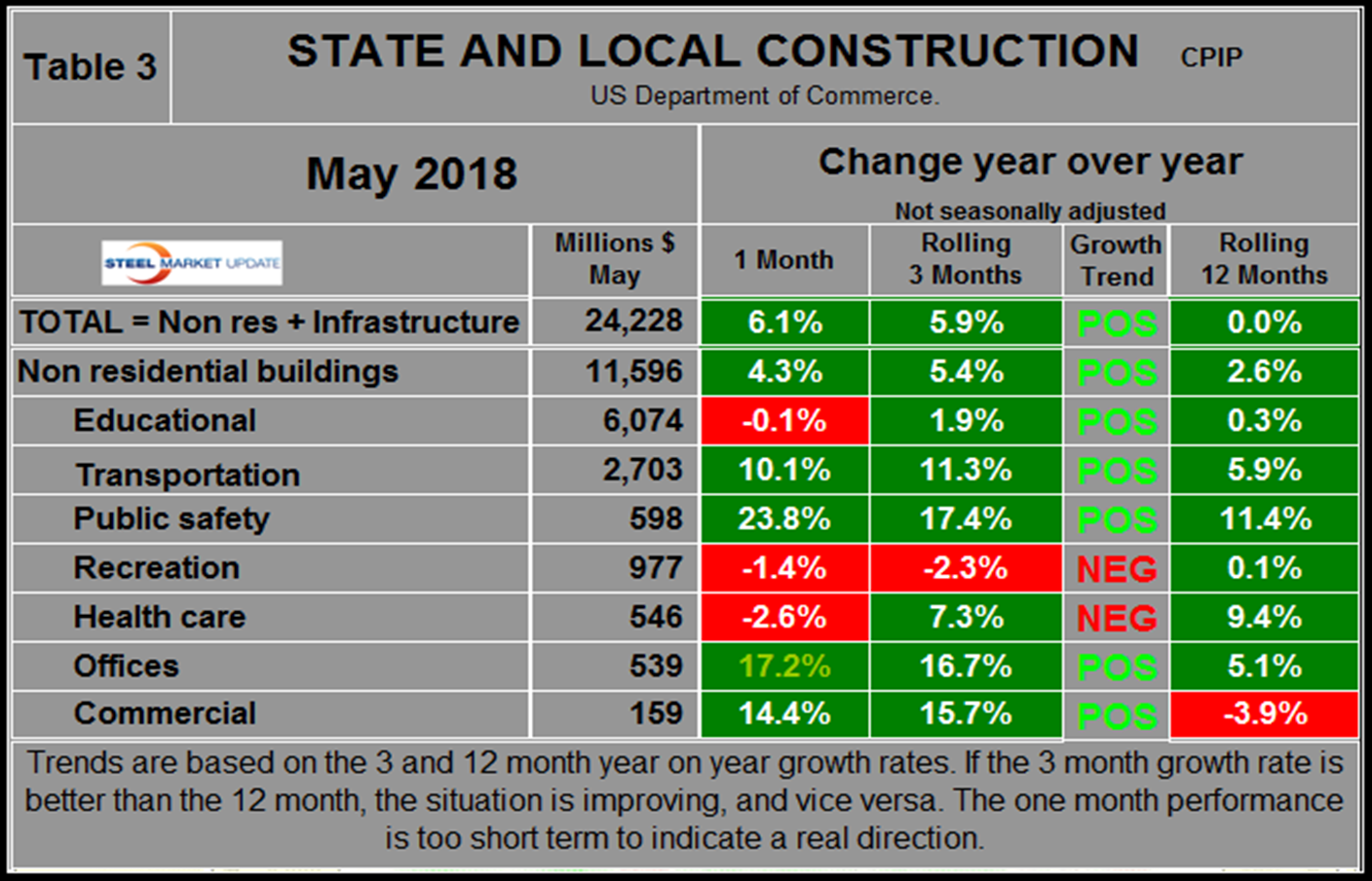
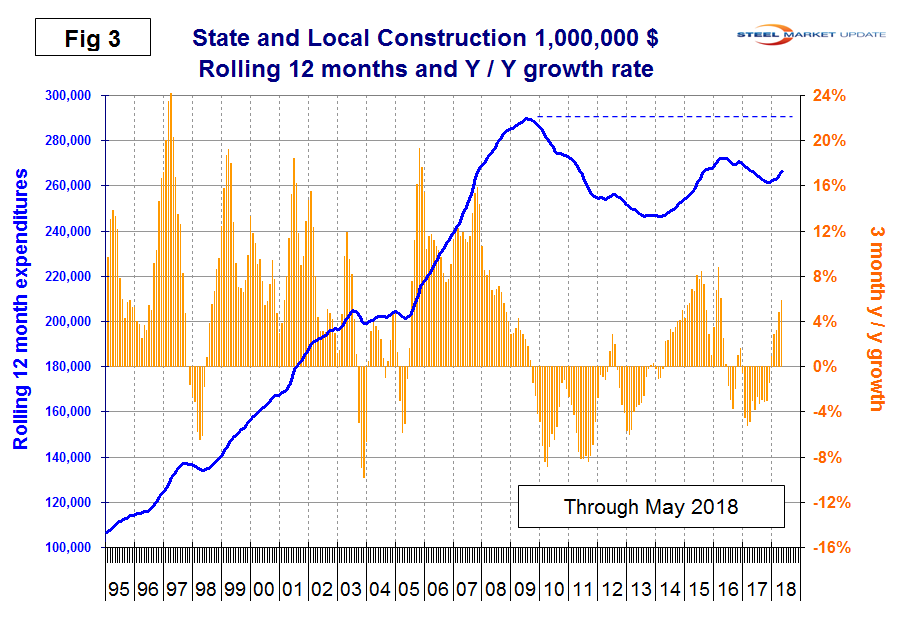
Drilling down into the private and S&L sectors as presented in Tables 2 and 3 shows which project types should be targeted for steel sales and which should be avoided. There are also regional differences to be considered, data for which is not available from the Commerce Department.
Infrastructure
Infrastructure expenditures peaked in early 2016 and declined through 2017 before beginning a recovery in 2018. May had a 5.4 percent growth rate. Highways and streets including pavement and bridges account for about two-thirds of total infrastructure expenditures. Highway pavement is the main subcomponent of highways and streets and saw 3.6 percent growth in three months through May. Bridge expenditures have expanded every month this year, improving to a 5.8 percent growth rate in May (Table 4).
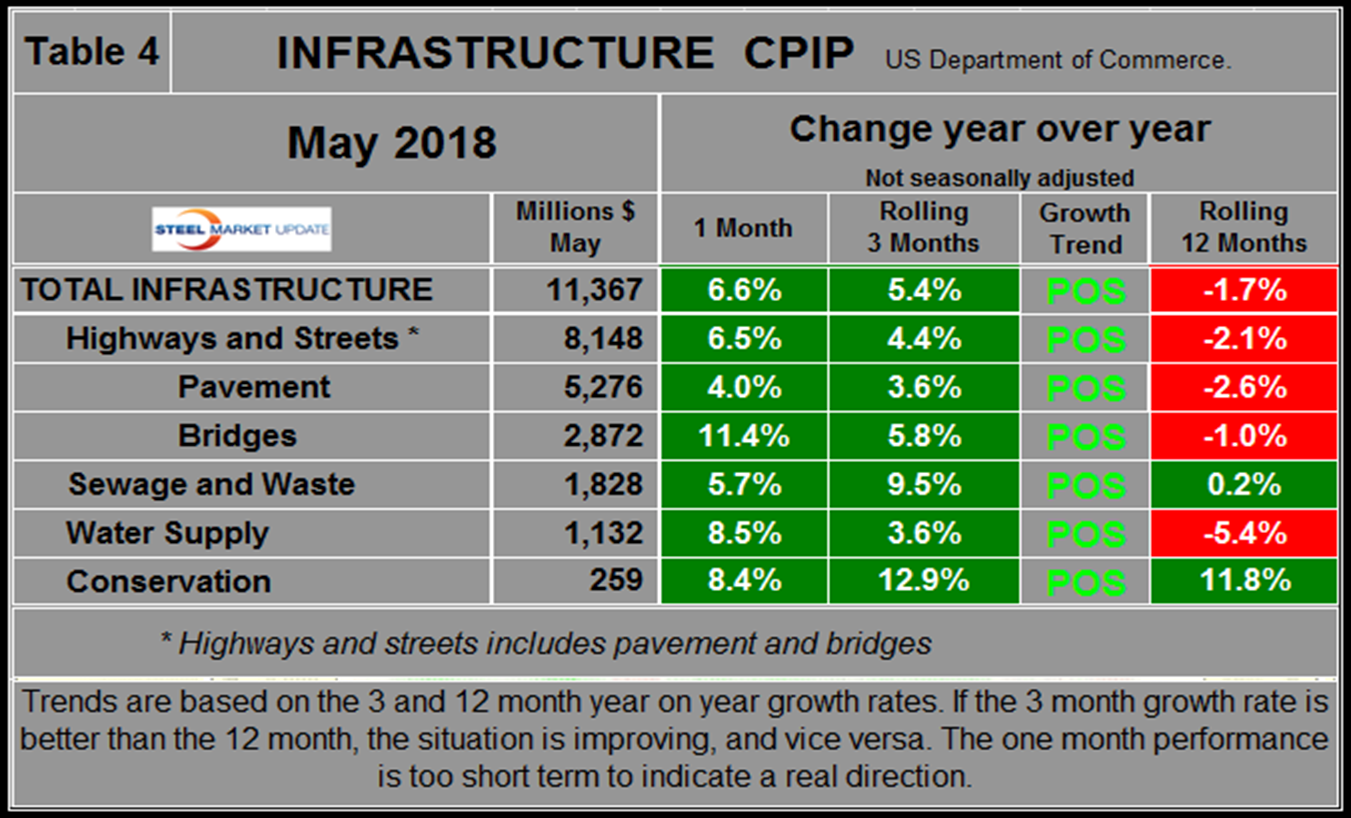
Figure 4 shows the history of infrastructure expenditures and the year-over-year growth rate.
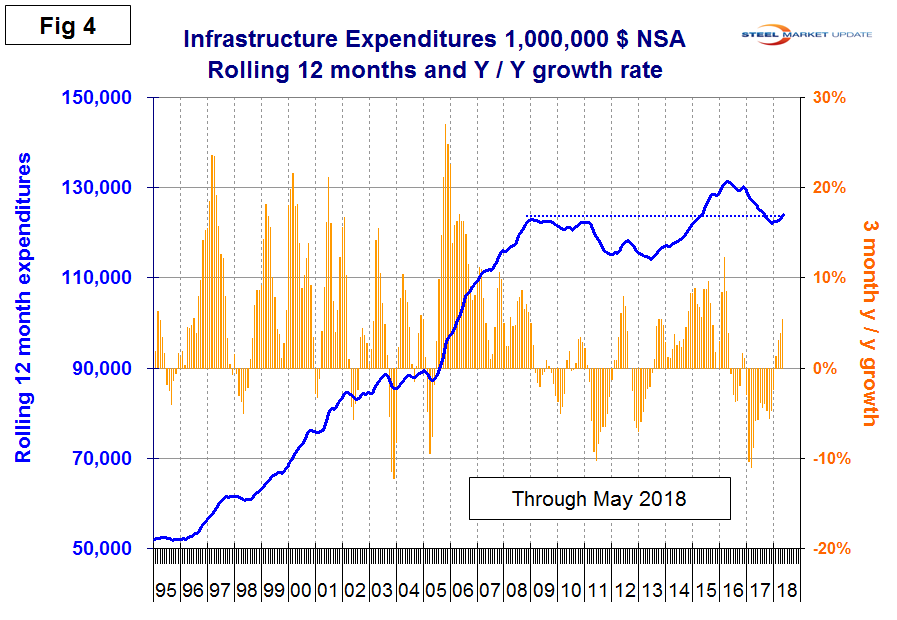
Total Building Construction Including Residential
Figure 5 compares year-to-date expenditures for building construction for 2017 and 2018. Single-family residential is dominant, and in the 12 months of 2017 totaled $264.5 billion, up from $242.5 billion in 2016. It seems likely that the 2018 tax bill, by its reduction in the deductibility of mortgage interest and local taxes, will negatively affect single-family home construction.
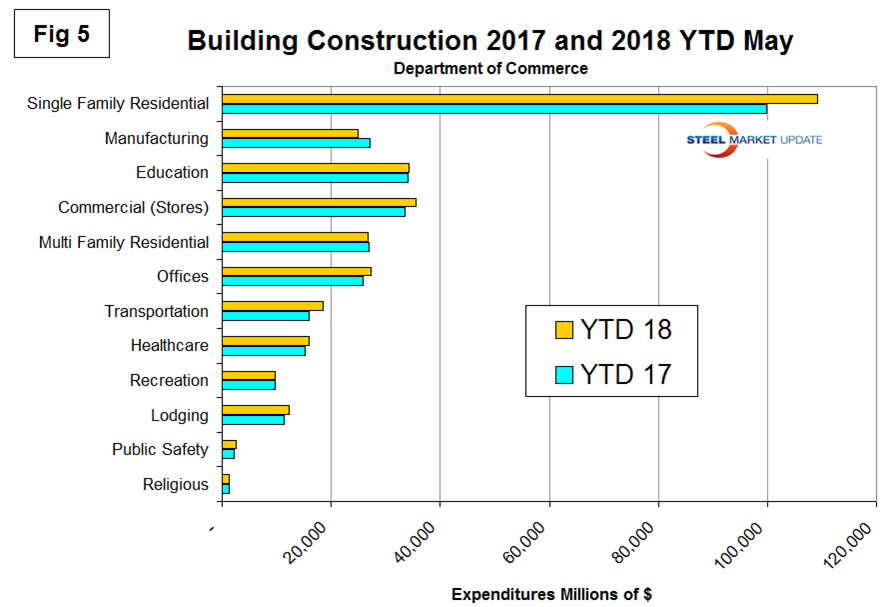
Figure 6 shows total expenditures and growth of nonresidential building construction. Growth slowed in January through July last year, went negative in August through October, then became increasingly positive in November through May 2018.
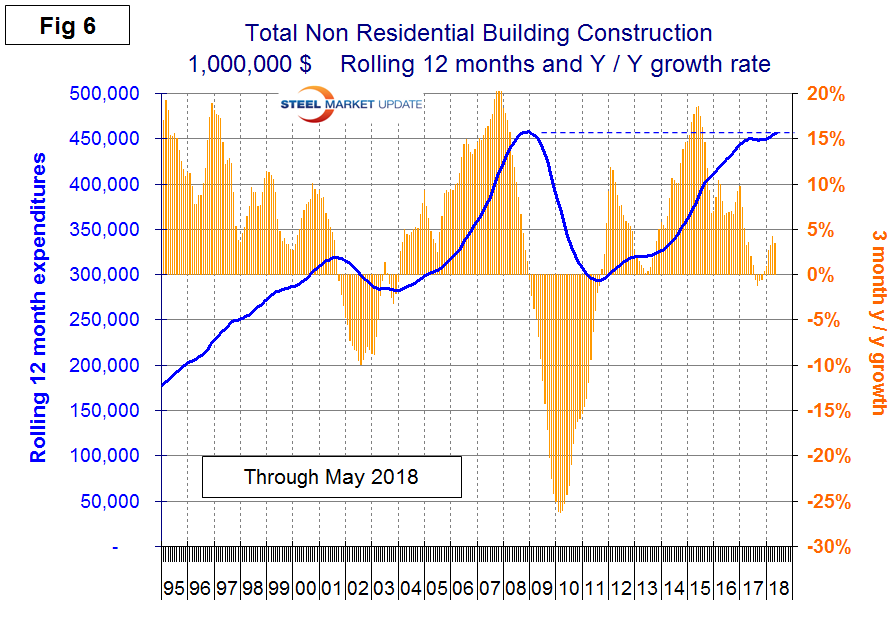
Explanation: Each month, the Commerce Department issues its construction put in place (CPIP) data, usually on the first working day covering activity one month and one day earlier. Construction put in place is based on spending work as it occurs, estimated for a given month from a sample of projects. In effect, the value of a project is spread out from the project’s start to its completion. This is different from the starts data published by the Census Bureau for residential construction, by Dodge Data & Analytics and Reed Construction for nonresidential, and Industrial Information Resources for industrial construction. In the case of starts data, the whole project is entered into the data base when ground is broken. The result is that the starts data can be very spiky, which is not the case with CPIP.
The official CPIP press release gives no appreciation of trends on a historical basis and merely compares the current month with the previous one on a seasonally adjusted basis. The background data is provided as both seasonally adjusted and non-adjusted. The detail is hidden in the published tables, which SMU tracks and dissects to provide a long-term perspective. Our intent is to provide a route map for those subscribers who are dependent on this industry to “follow the money.” This is a very broad and complex subject, therefore to make this monthly write-up more comprehensible, we are keeping the information format as consistent as possible. In our opinion, the absolute value of the dollar expenditures presented are of little interest. What we are after is the magnitude of growth or contraction of the various sectors. In the SMU analysis, we consider only the non-seasonally adjusted data. We eliminate seasonal effects by comparing rolling three-month expenditures year over year. CPIP data also includes the category of residential improvements, which we have removed from our analysis because such expenditures are minor consumers of steel.
In the four tables included in this analysis, we present the non-seasonally adjusted expenditures for the most recent data release. Growth rates presented are all year over year and are the rate for the single month’s result, the rolling three months and the rolling 12 months. We ignore the single-month year-over-year result in our write-ups because these numbers are preliminary and can contain too much noise. The growth trend columns indicate momentum. If the rolling three-month growth rate is stronger than the rolling 12 months, we define that as positive momentum, or vice versa. In the text, when we refer to growth rate, we are describing the rolling three-month year-over-year rate. In Figures 1 through 4 and 6, the blue lines represent the rolling 12-month expenditures and the brown bars represent the rolling there-month year-over-year growth rates.

Peter Wright
Read more from Peter WrightLatest in Steel Markets

USW cheers Evraz NA agreement with Atlas Holdings
The United Steelworkers (USW) labor union celebrated recent news of the signed agreement between Atlas Holdings and Evraz NA in which the Connecticut-based private equity company said it plans to acquire North America’s Evraz facilities.

Steel buyer spirits tempered by soft spot market conditions
Steel sheet buyers report feeling bogged down by the ongoing stresses of stagnant demand, news fatigue, tariff negotiations or implementation timelines, and persistent macroeconomic uncertainty.

Hot-rolled coil buyers continue seeking certainty
Steel market participants contend that buyers will remain in “wait-and-see" mode until some market stability is restored.

Latin American steel advocates warn on cheap import flood
Subsidized Chinese steel imports and cheap steel products from Association of Southeast Asian Nations (ASEAN) entering Latin American (LATAM) are threatening the region's steel market.

CRU: Steel prices fall amid global demand weakness
The forceful headwinds bearing down on steel markets across the globe have created demand challenges and sent prices southward. The US, however, challenged the global trend.
